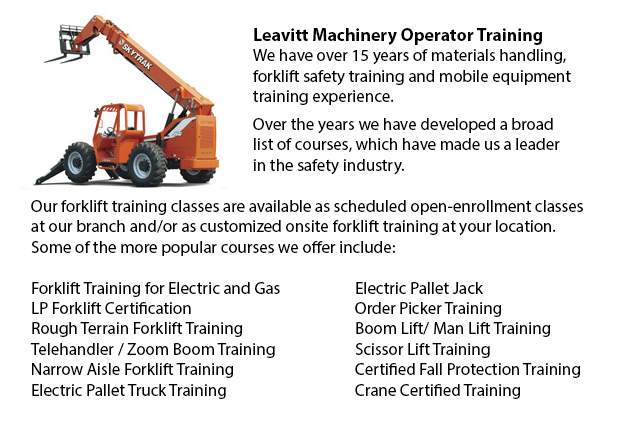
Oshawa Telehandler License - A telescopic handler or telehandler is a machine which is generally utilized in industrial and agricultural applications. It has a similar look to a lift truck and even functions in a similar way, even though, the telehandler is more of a crane than a forklift. It has a telescopic boom which can lengthen forward and upward from the motor vehicle. The boom has the capability to fit one of various accessories like muck grab, pallet forks, a bucket or a lift table.
Pallet tines are the most common attachment for the telehandler. This equipment is normally utilized for transporting loads to and from locations that a standard lift truck will find inaccessible. Telehandlers are particularly useful for placing loads on rooftops for example, or for removing palletized cargo from with a trailer. A lot of the jobs that a telehandler could complete would otherwise require a crane and this piece of equipment could be costly, not always time efficient and impractical.
The boom acts as a lever, extending and raising while bearing a load. Even though there are rear counterweights, this may cause the telehandler to become more unstable. Hence, the greatest advantage of the telehandler is also its greatest limitation. As the working radius increases, the lifting capacity lessens. The working radius is defined as the distance between the front of the wheels and the center of the load.
Like for example, a telehandler with a 5000 lb capacity with the boom retracted could safely lift as little as 400 lb once it is completely extended at a low boom angle. The equivalent equipment that has a 5000 lb lift capacity and the boom retracted could support as much as 10,000 lb with the boom raised to 70 degrees. The operator has a load chart to help determine whether a particular lifting job can be accomplished in an efficient and safe way. This particular chart takes into consideration the boom angle, the weight and height.
Various telehandlers come outfitted along with a computer which utilizes sensors so as to monitor the motor vehicle. These sensors will alert the operator and some are capable of cutting off further control input if the limits of the motor vehicle are exceeded. Some telehandler kinds are likewise outfitted along with front outriggers which are known as mobile cranes. These really extend the lifting capacity of the equipment while it is stationary.
-
Oshawa Scissor Lift Operator Certification
Oshawa Scissor Lift Operator Certification - North American regulators recommend that worksites need operators of scissor lifts, booms or aerial work platforms to obtain certification training. Scissor lift operator certification is not mandatory, bu... More -
Narrow Aisle Forklift / Order Picker Training / Electric Pallet Jack / Electric Pallet Truck Training in Oshawa
A pallet lift is a model of equipment dedicated in the moving of pallets of many dimensions and weights. They might be utilized as an appendage for platform lifts, cranes and other types of heavy machinery or be applied on their own. Pallet hoists ar... More -
Oshawa Crane Operator Certification
Oshawa Crane Operator Certification - The process to permit people to be able to operate certain kinds of cranes is to take crane operator certification training to get certification. The certification process incorporates classroom learning, hands-o... More -
Oshawa Aerial Platform Training
Oshawa Aerial Platform Training - Aerial platform lifts might be utilized to accomplish a lot of unique tasks executed in hard to reach aerial places. A few of the odd jobs associated with this style of lift include performing routine repair on build... More -
Oshawa Forklift Certification Schools
Oshawa Forklift Certification Schools - Forklift Certification is mandatory within North America. Hence, forklift training programs are important both for companies and for people seeking jobs in industries as forklift operators. Forklift training fo... More -
Oshawa Heavy Equipment Ticket
Oshawa Heavy Equipment Ticket - Depending on the nature of the job at hand, the type of construction equipment that a heavy equipment operator makes use of varies. Each and every type of machine is built to perform specific jobs in the most effective... More -
Oshawa Heavy Equipment Certification
Oshawa Heavy Equipment Certification - Large pieces of machines and heavy-duty vehicles are usually known as heavy equipment. This broad term includes utility vehicles from forestry and agricultural implements to civil engineering vehicles, construct... More -
Oshawa Overhead Crane Safety Training
Oshawa Overhead Crane Safety Training - The overhead crane safety training program is meant to equip the operators with the right skills and knowledge in the areas of: crane safety precautions, accident avoidance, materials handling, and equipment an... More

Forklift Certification Oshawa
TOLL FREE: 1-888-254-6157
Oshawa, Ontario
forkliftcertificationoshawa.com
Email Us
About Us


